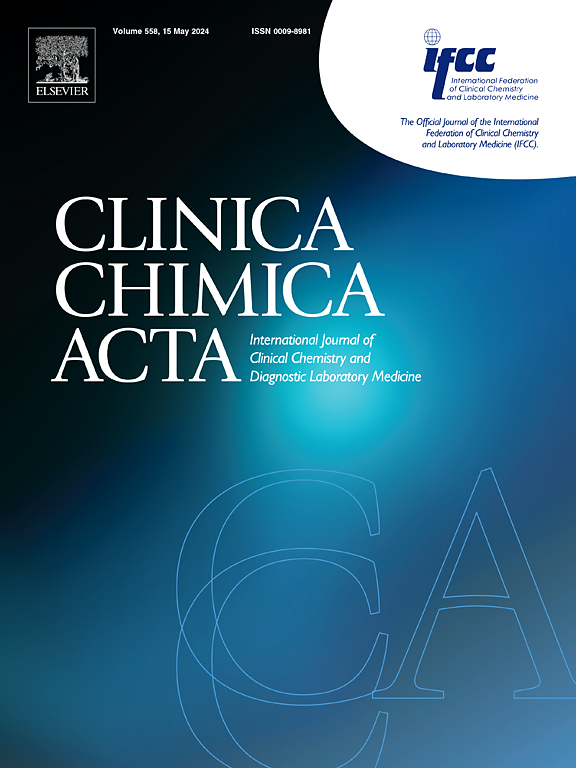Evaluation of six GFR estimation equations in Chinese patients with chronic kidney disease
IF 2.9
3区 医学
Q2 MEDICAL LABORATORY TECHNOLOGY
引用次数: 0
Abstract
Background
Glomerular filtration rate (GFR) is recognized as the most reliable indicator of renal function and is usually estimated based on the serum creatinine equations. However, the reliability of these equations in specific regions needs to be properly quantified. We evaluated the applicability of the abbreviated MDRD equation (aGFR), the modified abbreviated MDRD equation (maGFR), the CKD-EPI creatinine equation (C-GFRcr), the CKD-EPI creatinine-cystatin C equation (C-GFRcr-cys), the EKFC creatinine equation (E-GFRcr), and the EKFC creatinine-cystatin C equation (E-GFRcr-cys) to chronic kidney disease (CKD) patients in Chongqing, China.
Methods
A total of 234 adult patients with CKD were selected for the study. Their sex, age, and etiology of CKD were recorded, and serum creatinine and cystatin C were measured and traceable to primary reference materials. The technetium 99 m-labeled diethylenetriamine pentaacetate (99mTc-DTPA) renal scintigraphy was used as the reference method for GFR measurement. Six GFR estimation equations were analyzed in the overall analysis and across various stages of CKD to evaluate differences, absolute differences, bias, precision, and accuracy.
Results
In the validation dataset, the differences for maGFR were smaller compared to other equations, while those for C-GFRcr-cys and E-GFRcr-cys were larger. The bias for C-GFRcr-cys and E-GFRcr-cys was significantly higher than that of the other equations, although all six equations exhibited similar levels of precision. In CKD stages 1 through 3, the accuracy of C-GFRcr-cys and E-GFRcr-cys was significantly lower when compared to the other equations. Conversely, in CKD stages 4 and 5, maGFR and E-GFRcr-cys demonstrated significantly greater accuracy than the other equations. In CKD stage 1, maGFR misclassified only 5.21 % of patients, whereas C-GFRcr-cys and E-GFRcr-cys had significantly higher misclassification rates of 66.67 % and 68.75 %, respectively, compared to the other equations.
Conclusions
Overall, maGFR performed better than other equations and can be used as a confirmatory test in CKD patients in Chongqing, China.
中国慢性肾病患者6个GFR估计方程的评价
肾小球滤过率(GFR)被认为是肾功能最可靠的指标,通常是根据血清肌酐方程来估计的。然而,这些方程在特定区域的可靠性需要适当量化。我们评估了缩写MDRD方程(aGFR)、修改缩写MDRD方程(maGFR)、CKD- epi肌酐方程(C- gfrcr -cys)、CKD- epi肌酐-胱抑素C方程(C- gfrcr -cys)、EKFC肌酐方程(E-GFRcr)和EKFC肌酐-胱抑素C方程(E-GFRcr-cys)在中国重庆慢性肾病(CKD)患者中的适用性。方法选择234例成年CKD患者作为研究对象。记录他们的性别、年龄和CKD的病因,测量血清肌酐和胱抑素C,并可追溯到主要参考物质。采用锝99m标记五乙酸二乙烯三胺(99mTc-DTPA)肾显像作为GFR测定的参考方法。在整体分析和CKD不同阶段分析了6个GFR估计方程,以评估差异、绝对差异、偏差、精度和准确性。结果在验证数据集中,maGFR与其他方程的差异较小,而C-GFRcr-cys和E-GFRcr-cys的差异较大。C-GFRcr-cys和E-GFRcr-cys的偏差明显高于其他方程,尽管所有六个方程都表现出相似的精度水平。在CKD 1至3期,与其他方程相比,C-GFRcr-cys和E-GFRcr-cys的准确性明显较低。相反,在CKD 4期和5期,maGFR和E-GFRcr-cys的准确性明显高于其他方程。在CKD 1期,maGFR错分率仅为5.21%,而C-GFRcr-cys和E-GFRcr-cys的错分率明显高于其他方程,分别为66.67%和68.75%。结论总体而言,maGFR优于其他方程,可作为中国重庆CKD患者的确证性检验。
本文章由计算机程序翻译,如有差异,请以英文原文为准。
求助全文
约1分钟内获得全文
求助全文
来源期刊

Clinica Chimica Acta
医学-医学实验技术
CiteScore
10.10
自引率
2.00%
发文量
1268
审稿时长
23 days
期刊介绍:
The Official Journal of the International Federation of Clinical Chemistry and Laboratory Medicine (IFCC)
Clinica Chimica Acta is a high-quality journal which publishes original Research Communications in the field of clinical chemistry and laboratory medicine, defined as the diagnostic application of chemistry, biochemistry, immunochemistry, biochemical aspects of hematology, toxicology, and molecular biology to the study of human disease in body fluids and cells.
The objective of the journal is to publish novel information leading to a better understanding of biological mechanisms of human diseases, their prevention, diagnosis, and patient management. Reports of an applied clinical character are also welcome. Papers concerned with normal metabolic processes or with constituents of normal cells or body fluids, such as reports of experimental or clinical studies in animals, are only considered when they are clearly and directly relevant to human disease. Evaluation of commercial products have a low priority for publication, unless they are novel or represent a technological breakthrough. Studies dealing with effects of drugs and natural products and studies dealing with the redox status in various diseases are not within the journal''s scope. Development and evaluation of novel analytical methodologies where applicable to diagnostic clinical chemistry and laboratory medicine, including point-of-care testing, and topics on laboratory management and informatics will also be considered. Studies focused on emerging diagnostic technologies and (big) data analysis procedures including digitalization, mobile Health, and artificial Intelligence applied to Laboratory Medicine are also of interest.
 求助内容:
求助内容: 应助结果提醒方式:
应助结果提醒方式:


